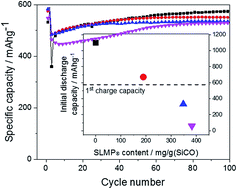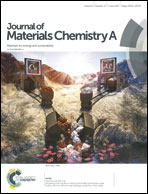Silicon carboxylate derived silicon oxycarbides as anodes for lithium ion batteries†
Abstract
A novel and facile procedure was developed to synthesize silicon oxycarbides which are suitable anode materials for lithium ion batteries. Silicon tetraacetate was thoroughly mixed with varying amounts of citric acid and the mixtures were thermally treated at lower temperatures of up to 250 °C for several hours. The mixtures start to melt at around 150 °C. Acetic acid and acetic anhydride may then continuously be removed via distillation until the mixture starts to solidify. The degree of substitution may be controlled by the amount of citric acid. The resulting solids were then carbonized under an inert gas atmosphere at a temperature of 1000 °C. Black solids were obtained whose chemical composition and morphology were characterized in detail. X-ray diffraction (XRD) confirmed the amorphous nature of the materials. With X-ray photoelectron spectroscopy (XPS) we were able to analyze the chemical environment of the silicon atoms in more detail. Compared to fumed silica the Si 2p detail spectra show another peak at lower binding energy, which can be attributed to oxycarbide species. XPS also allowed us to determine the O/Si ratio from which a chemical formula for the SiCO materials could be derived. The materials also contain a significant amount of free carbon, which improves electrical conductivity and thus the electrochemical properties. In order to elucidate the potential of the materials as anodes for lithium ion batteries, galvanostatic charge/discharge measurements were conducted. Within the cut off potentials of 0.005–1.5 V, the materials showed high capacities of up to 590 mA h g−1 at a current of 50 mA g−1. To overcome the irreversible capacities in this system, a prelithiation approach via spray coating with stabilized lithium metal powders (SLMP®) was successfully applied. The electrodes, fabricated with lithiated polyacrylic acid (LiPAA) as binder, maintained the cycling characteristics of their non-lithiated counterparts, even if the anode was almost completely lithiated.



 Please wait while we load your content...
Please wait while we load your content...